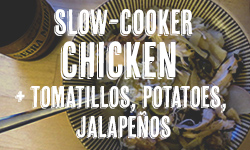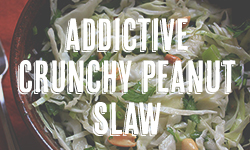Killer spinach risotto with nutmeg and lemon
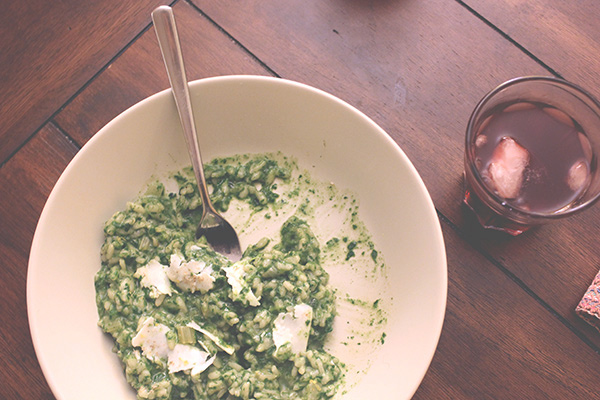
Me from five years ago would be skeptical to see me here talking about risotto, since it was only a few years back I took any interest in it at all, and even more wary to see me recommending something with spinach, since even just a couple of weeks ago I wouldn’t have believed I could do such a thing. But here I am, heartily recommending both, and hoping this ends up on your table either for New Years or some time early in the new year.
What’s my deal with spinach? Categorically greens don’t get me going in the same way they do for many (especially these days), but spinach even less so, since it often leaves my mouth feeling grainy, gritty, and squeaky (in the same way American Coca-Cola does – and I’ve heard others say the same thing about these two items, so there must be some strange connection between them). Its flavor doesn’t seem worth risking what it does to my mouth, so it doesn’t end up on my plate very often. It’s not even that I dislike it, so much, just that there are so many other things I’d choose in its place.
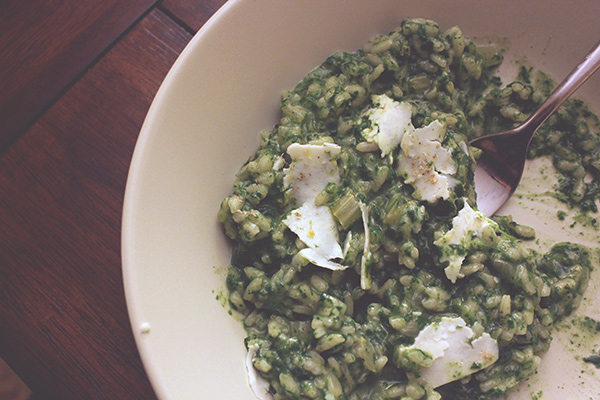
But, here we are in Madison, within easy access of Snug Haven Farm’s infamous frost-sweetened winter spinach (they supply to many of the highest-end restaurants in the Upper Midwest, and we’re lucky to have them at our farmers’ market as well), and I was told I’d be sorry if I missed it. So we picked up a half-pound bag at the farmers’ market, figuring some sort of plan for it would follow, and when a sampling of the leaves left us feeling like maybe we just don’t get spinach, I looked to a recipe that might incorporate it more as a flavor base than a distinct ingredient.
In the end, I sauteed the leaves and stems whole in a knob of butter with a healthy grating of nutmeg and a squeeze of lemon, pureed it all, and stirred it into a finished batch of risotto, finishing it all with a few more gratings of nutmeg, some lemon zest, and some shaved ricotta salata. The color of the finished dish was incredible, deeply forest green, and the flavor was even better – strongly like spinach but perfectly balanced by the nutty, creamy flavors of the risotto, cheese, and nutmeg and by the tartness of the lemon juice and bright notes from the zest.
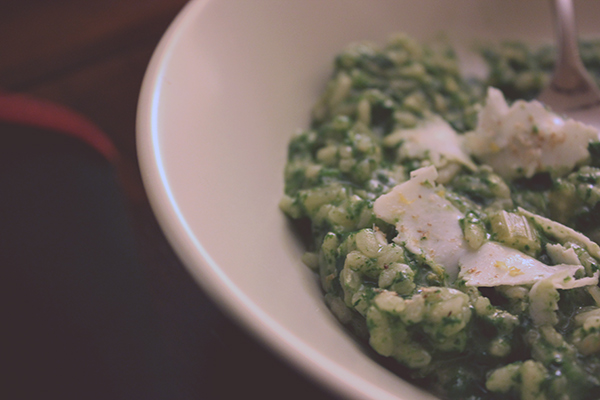
So, here’s me recommending something with spinach. If you’re lucky enough to get your hands on some of the wonderful frost-sweetened varieties (that is, if you’re lucky enough to live somewhere with frost), choose that – it’ll have much more flavor than the bagged supermarket kind. But any should be fine here.
Spinach risotto
Inspired by Jamie OliverServes 4, easily scalable
- 1 batch basic risotto for spinach risotto (recipe below; adapted and scaled from this post).
- 1/2 lb. fresh spinach, washed and dried (stems can be included, unless they’re woody or tough – if the spinach is still attached in bunches, separate them or chop off where they’re connected)
- 2 Tbsp. butter
- Nutmeg (freshly grated is preferred, but dried ground is okay too – for seasoning and serving)
- Juice (for seasoning) and zest (for serving) of 1/2 lemon
- Ricotta salata, for serving (goat cheese, feta, or other crumbly, salty cheeses would work well too)
- Salt, to taste
– Make a batch of risotto according to recipe below.
Meanwhile:
– Saute, season, and puree spinach Heat the butter in a large skillet over medium-high heat. When the butter is melted, add the whole spinach leaves. Use tongs or another utensil to toss and stir the leaves until they’re entirely wilted. Grate the zest off 1/2 a small-to-medium lemon, and set aside. Squeeze the juice into the spinach and add a few gratings of nutmeg (or a couple of small pinches of dried ground nutmeg). Stir or toss to combine. Transfer the spinach to a blender or food processor and blend until smooth.
– Assemble dish and serve Stir the spinach mixture into the finished risotto along with a few small splashes of water (or enough to reach desired consistency – some people like soupier risotto; some like it more firm). Add salt to taste (if needed). Serve and garnish with shaved (use a vegetable peeler), grated, or crumbled ricotta salata, a few gratings of nutmeg (or a pinch of dried ground nutmeg) and the lemon zest.
Making ahead/storage: This finished dish will keep well in the refrigerator for a few days, but will firm up and need a bit of water or other liquid when re-heated (also likely a bit more salt). You can also make the spinach fresh and add it to pre-made risotto, which should be heated separately and will likely need a bit of liquid added before the spinach is incorporated.
Basic risotto for spinach risotto recipe
Scaled and slightly adapted as a 2x batch from this post (this version does not include Parmesan or pepper)
- 1 onion, diced
- 2-3 stalks celery, diced
- 2-4 Tbsp. butter and/or olive oil
- 2 cup (250 g) risotto rice, like arborio or carnaroli (don’t rinse the rice ahead of time)
- Around 1/2 to 1 cup dry white wine or vermouth
- 6 to 8 cups warmed vegetable or meat stock (warm water would work too, but would give far less flavor)
- Salt
– Cook vegetables In a medium saute pan or pot (the heavier the better – it will disperse heat more evenly), cook the diced onion and celery in the butter and/or olive oil until translucent.
– Toast the rice Stir in the rice and cook until it has soaked up the moisture in the pot, then for another bit (30 seconds or so). Stir occasionally during this process, just to make sure things aren’t sticking to the bottom of the pot and burning. The rice will start to smell a bit toasty and get translucent around the edges.
– Add the wine Pour in your wine or vermouth and stir. It will steam and make a racket since the pan will be pretty dry, but that’s okay. Cook, stirring every so often, until the alcohol has cooked off (when you can’t smell alcohol anymore, just wine) and the rice has soaked up most of the liquid.
– Add stock in increments and stir Start adding stock in increments, somewhere around a 1/2 cup at a time, keeping the mixture at a low bubble. Stir fairly consistently through the cooking process, scraping along the bottom of the pot to make sure the rice isn’t sticking to the bottom of the pan – because that rice is releasing all that lovely starchy sauce, it can start to stick fairly easily. Your first few times, it’s best to stir almost the entire time, to get used to how the process progresses. After a while you’ll be able to do other things in your kitchen between stirrings, but even experienced risotto makers have somewhat of a tether to the pot while it’s going. Whenever liquid doesn’t pool at the bottom of the pan while you’re stirring, add another batch of stock. Do this process for somewhere between 15-25 minutes (or maybe more, even), stirring and adding stock until the rice is cooked through. Start tasting around minute 12 so you know how progress is going, and as it gets close start adding less stock each time so you don’t end up with soupy risotto. When done, risotto rice will taste a bit al dente and chewy, but it should be enjoyable to eat – not crunchy or unpleasantly undercooked.
– Remove from heat and season When the rice is tender, remove it from the heat or turn off the burner. Add a bit more stock if you’d like it to have a looser texture, then add salt to taste. Continue with spinach risotto recipe above.











